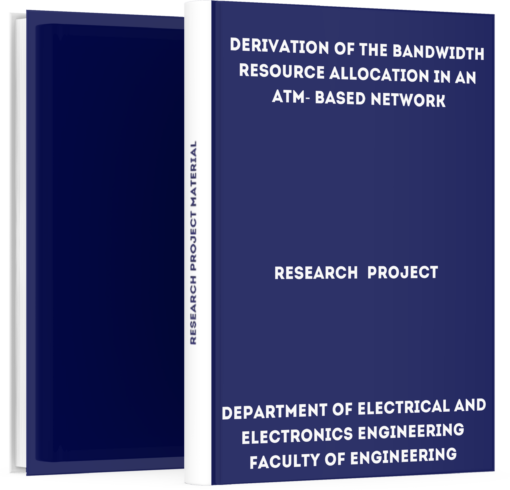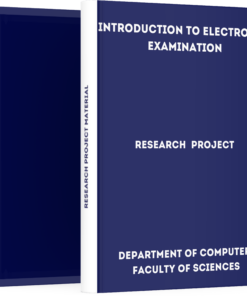Derivation of the Bandwidth Resource Allocation in an Atm- Based Network
₦3,000.00
If you are interested in getting this project material “Derivation of the Bandwidth Resource Allocation in an Atm- Based Network”, click on the DOWNLOAD BUTTON to make payment and the file will be delivered to your email immediately after confirmation.
Description
– Derivation of the Bandwidth Resource Allocation in an Atm- Based Network –
Download Derivation of the Bandwidth Resource Allocation in an Atm- Based Network. Students who are writing their projects can get this material to aid their research work.
Abstract
Asynchronous Transfer Mode (ATM) technology is the transfer mode for implementing a Broadband-Integrated Services Digital Network (B-ISDN). ATM defines multiplexing and switching techniques for broadband signals. Synchronous Optical Network (SONET) is employed in the B-ISDN backbone.
The main objective of an ATM is to guarantee Quality of Service (QoS) in transfer of cell streams across networks. This technology recommended as the transport vehicle for the B-ISDN offers a great flexibility to transmission bandwidth allocation to accommodate diverse demands of multimedia connections.
Dynamic Bandwidth Allocation (DBA) is a fundamental factor in network performance for an ATM-based bursty traffic. However, the fundamental problem in ATM network is defining the way to allocate bandwidth optimally especially for unpredictable bursty traffic.
This project aims at developing the approach to the derivation of the bandwidth resource allocation in an ATM-based network. The main tool used for the simulation is Riverbed Modeler 2014 Academic Edition 17.5 (OPNET).
This project developed the intended format with bandwidth allocation guide for N* 64kbps of a Primary Rate Interface (PRI) T1 trunk lines for varying delay, loss and buffer occupancy.
The allocation was developed for varying traffic intensity between 0 and 320 Kbps corresponding to five channels of 64kbps each. Cell Loss Probability (CLP) standards between 0.0000875 and 0.002967 were considered. The Buffer Occupancy values were between 0.00000237KB and 0.0000117KB.
Introduction
1.1 Background of the Study
In digital communications, bandwidth as a concept has to do with the amount of data a link or network path can deliver per unit of time. For many multimedia applications, the available bandwidth has direct impact on the applications’ performance.
The terms bandwidth and throughput often characterize the amount of data that the network can transfer per unit of time.
Bandwidth plays a significant influence in several network communications. Several applications can benefit from knowing the bandwidth characteristics of their network paths.
Network providers present lists of bandwidth bouquet from which interested users select and are billed. The customers’ subscription to the service provider leads to traffic contract which will finally result in signing of Service Level Agreement (SLA).
The rate of bandwidth utilization by various customers makes the providers to plan for capacity upgrade or expansion for the network to avoid congestion, traffic drop or total collapse of the network.
It is a standard that bandwidth utilization of above 70% is an invitation to heavy congestion in which case various methods are encourage to avoid such state of congestion.
Although network providers can effectively monitor bandwidth utilization through traffic policing and shaping, it is however not the same from the customers point of view.
To achieve this network administrator with administrative privileges and access to the network devices such as routers or switches may connect to a link of interest in order to measure the bandwidth using the Simple Network Management Protocol (SNMP).
How to Download this Project Material
First, note that we are one of the best and most reliable online platforms because we don’t retain any of your personal information or data as regards making payments online.
PRICE: ₦3,500 ₦3,000 (Three Thousand Naira Only)
Make a bank deposit or mobile transfer of ₦2,000 only to the account given below;
Bank Name: UBA Account Number: 1022564031 Account Name: TMLT PRO SERVICES
After making the payment, CLICK HERE to send the following on WhatsApp;
- Depositor’s Name or Screenshot of Payment
- Name of the Past Question
- Active Email Address
or Call Us On +2348082284439 Once your details have been received and your payment confirmed by us, you will receive the past question in your email or WhatsApp within 5 Minutes.
Guarantee of Getting the Material
We understand that due to the high rate of fraud, many people are afraid of making purchases online but be rest assured that PastExamQuestions will deliver your material after payment.
Once your details have been received and your payment confirmed by us, you will receive the past question in your email or WhatsApp.
Give us Feedback
Have we been able to satisfy you? How well do you think the material will be helpful after having gone through it? Does the price worth the material?
Let’s hear from you! We recommend that our customers give feedback at the end of every transaction to enable us to serve better. You can do this by clicking the review button on this page.
Where is the review button? >> Just scroll up to where you see reviews





Reviews
There are no reviews yet.